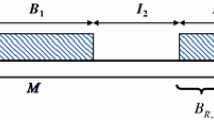Abstract
This paper is concerned with the analysis of an asynchronous transfer mode (ATM) multiplexer serving bursty applications such as voice, image, and high-speed data. The model used is a ∑GI i /D/1 discrete-time single-server queueing system: the arrival process is a superposition of several random processes, and the departure process is a deterministic with a FCFS discipline. The difficulty in solving such a queueing system depends on the model chosen for the individual traffic sources. For the case in which the cell arrival stream from the individual sources is modeled as a Bernouli process, an exact solution is possible. The problem with such a model is that it does not incorporate the effect of burst length, which has been shown through simulation experiments to have a significant effect on the performance. A more realistic model that takes into consideration the impact of the burst length is considered in this study. In particular, an alternating-state Markov process is chosen to model the individual arrival stream.
The solution of a ∑GI i /D/1 queueing system with the arrival process being a superposition of several renewal processes is in general intractable. This paper obtained a new approximation we refer to as the three-parameters approximation (TPA). This approximation was based on the asymptotic properties of the aggregate traffic and the congestion estimates from the simulation experiments. The TPA solution was found to be dependent on three parameters: number of sources, overall traffic intensity at the queue, and multiplexing factor. The TPA is an improvement of a previous approximation developed in analyzing packet voice system.
In addition, the study determined an optimal operating point for the ATM multiplexer and the ATM switch that takes into account the tradeoff between delay and throughput. In particular, an optimal operating point is specified by the traffic loading that maximizes the queueing power. This optimal operating point is used to contrast the performance of ATM with synchronous transfer mode (STM).
Similar content being viewed by others
References
S.L. Albin, Approximate a point process by a renewal process, II: Superposition arrival processes to queues, Oper. Res. 32 (1984) 1133–1162.
E. Cinlar, Superposition of point processes, in:Stochastic Point Processes: Statistical Analysis, Theory, and Applications, ed. P.A.W. Lewis (Wiley, New York, 1972) pp. 549–606.
D.R. Cox and P.A.W. Lewis,The Statistical Analysis of Series of Events (Methuen, London, 1966).
J.N. Daigle and J.D. Langford, Models for analysis of a packet voice communication system, IEEE J-SAC (Sept. 1986) 847–855.
H. Heffes and D.M. Lucantoni, A Markov-modulated characterization of packetized voice and data traffic and related statistical multiplexer performance, IEEE J-SAC (Sept. 1986) 856–867.
J. Kohli, Medical imaging applications of emerging broadband networks, IEEE Commun. Mag. (Dec. 1989) 8–16.
P. Kuehn, Approximate analysis of general queueing networks by decomposition, IEEE Trans. Commun. COM-27 (1979) 113–126.
W. Lidinsky, Data communications needs, IEEE Commun. Mag. (March 1990) 28–83.
N.M. Marafih and R.L. Pickholtz, Performance models and congestion analysis of high speed multimedia networks, Dissertation Thesis, The George Washington University (1991).
N.M. Marafih, Ya-Qin Zhang and R.L. Pickholtz, modeling and queueing analysis of variable-bit-rate coded video sources in ATM networks, IEE Trans. Circuits & Systems for Video Tech. 4 (1994) 121–129.
M.F. Neuts, A versatile Markovian point process, J. Appl. Prob. 16 (1979) 746–779.
K. Sriram and W. Whitt, Characterizing superposition arrival processes in packet multiplexers for voice and data, IEEE J-SAC (Sept. 1986) 833–846.
W. Whitt, Approximating a point process by a renewal process, I: Two basic methods, Oper. Res. 30 (1982) 125–147.
W. Whitt, The queueing network analyzer, Bell Syst. Tech. J. 62 (1983) 2779–2815.
D.J. Wright and M. To, Telecommunication applications of the 1990s and their transport requirements, IEEE Commun. Mag. (March 1990) 134–139.
Author information
Authors and Affiliations
Rights and permissions
About this article
Cite this article
Marafih, N.M., Pickholtz, R.L. & Zhang, Y.Q. A new approximation for analyzing the multiplexing of bursty sources in ATM networks. Telecommunication Systems 4, 3–31 (1995). https://doi.org/10.1007/BF02110075
Issue Date:
DOI: https://doi.org/10.1007/BF02110075




